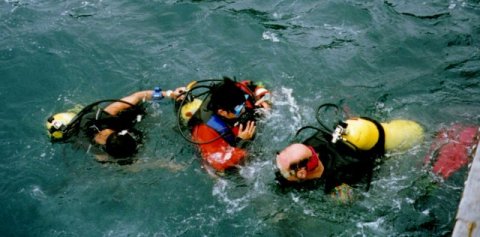
They managed to persuade seven local divers - much to their credit - to take up the course. They would receive both theoretical and practical instruction in a diving technique not featured in Singapore's recreational diving scene. At the very least, they were told, dry suit diving in the tropics would be an interesting experience.
The M/V Empress was chartered as a two-day "floating school" for the BSAC Advanced Instructor qualification. Seizing the opportunity once again, we had our course conducted on the same "School".
On the evening of 28 July, 1998, the seven of us boarded the M/V Empress for the class and boat to get underway. The theoretical considerations covered: buoyancy control, suit squeeze, thermal insulation concerns as well as various suit construction and control systems. The safety and rescue aspects were also covered. The class ended with a discussion on equipment compatibility and care and maintenance of the suit. We retired for the night still wondering... dry suits in the tropics? Mad dogs and Englishmen indeed!
The M/V Empress moored off Pulau Aur in the morning and Deric led us through the practical aspects of dry suit diving: Putting on and taking off the suit; inflating and deflating; proper weighting; neutral buoyancy checks and, finally, coping and recovering from suit blow-up and inversion.
Finally, we were allowed to put all we have digested into practice. Being ever so conscious of the heat, we kitted up in the shade. Much to our surprise, it was not as uncomfortably hot as we imagined, even though we had thermal under suits and bootees on. Once in the water, it was rather cool and pleasant.

A dry-suit means exactly that. The diver's body remains dry, sealed off from the elements at the neck and wrists. Even though a wetsuit does provide thermal insulation, there is always a layer of water - one of nature's most effective absorbers of heat - between the suit and the diver's body. The dry suit is supposed to prevent water from coming into contact with the diver's body and allow an insulating layer of air trapped in the under suits to prevent heat loss. There is a LP hose running from the regulator's first stage to an inflation valve on the suit to ensure that the air needed to effect this insulation is always available. In a nutshell, it's like diving in an air bubble surrounding your body!
The problems associated with trying to dive in an air bubble, and one that might be purposefully or arbitrarily inflated or deflated, is fairly obvious. So, we were taught to deal with the fairly obvious and not-so-obvious. Surface exercises saw us experiencing full suit inflations with the accompanying loss of manoeurability that it creates and practising various recovery techniques commonly used. This was followed by the practising of the inflation and deflation controls and buoyancy adjustments before our ascent/descent drills.
Underwater, at last. It was strange, for a previously wet suited diver, to actually feel the effects of water pressure on the air inside the suit during our descent. The "Squeeze" was easily solved, before it gets too uncomfortable, by introducing more air into the suit with the inflator.
The use of air as an insulator also adds to the diver's buoyancy. Additional weights were needed to negate this. Each of us took on an addtional four to ten kg. of weights before neutral buoyancy can be achieved. We were assured that, with experience, fewer weights would be needed.
While we anticipated that there were going to be problems with overheating, in reality, the problems were caused by improper suit sizes. There were only two suits available for the course and they only fitted the largest of the class. The more petite divers in the class found the legs of the suit too long for them and just had to make do by taking up the excess material somehow. They seemed to be managing until the inversion or blow up drill. The legs of the suit inflated and stretched to their full length, the feet of the diver popped out of the boot as a result and finning then became impossible. The sight, rather comical to say the least, taught us an important lesson: make sure your dry suit is the right size!
How did we feel about the course? It was a most interesting experience - definitely one worth logging. Though we did not experience the extremities of heat anticipated, moving around the boat kitted up will help your weight loss program. Lastly, we now know, at least seven Singaporean divers are ready for the Antartic. Oh no, have we succumbed to another one of Y C Lee's wild ideas?